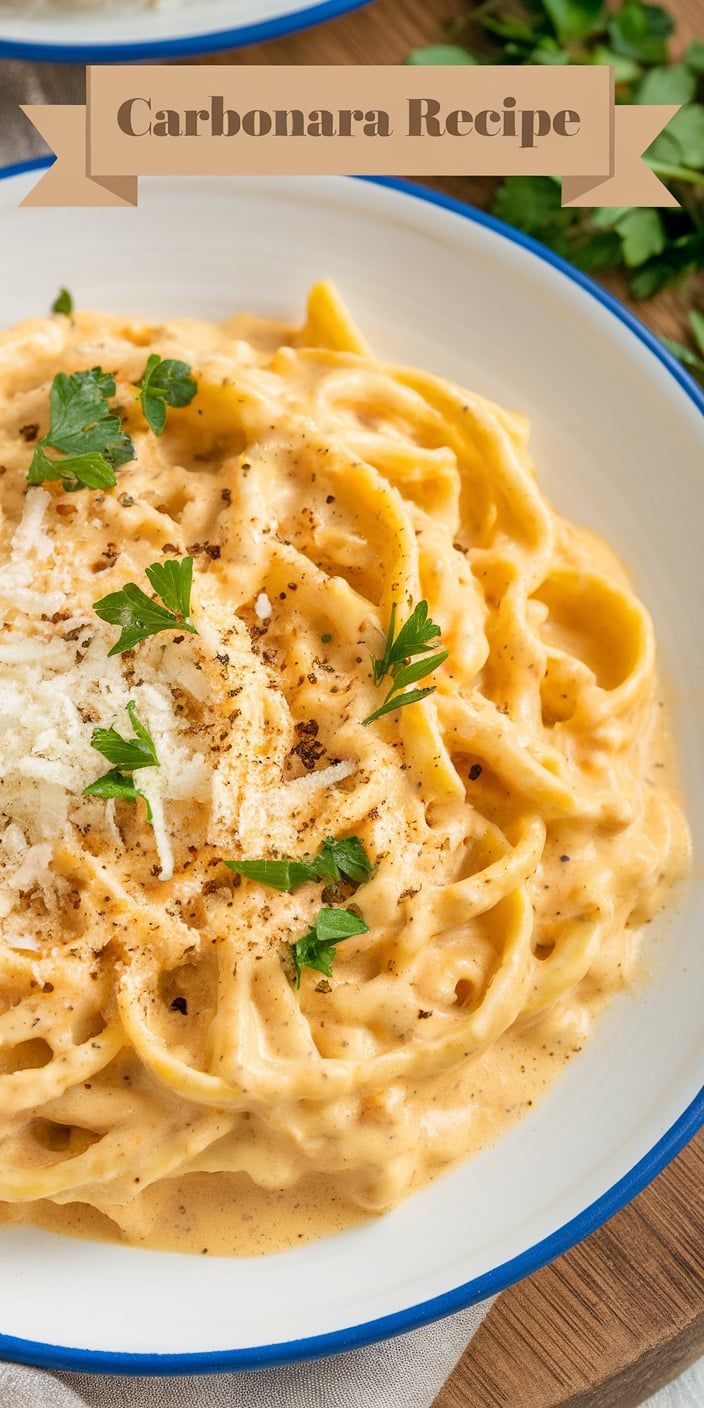Dive into the world of an authentic Italian pasta dish that has captured hearts worldwide. My carbonara recipe is a testament to the simple yet luxurious culinary traditions of Rome. This creamy pasta combines just a few ingredients to create a magical dining experience that transforms everyday cooking into something extraordinary.
At its core, carbonara is a masterpiece of Italian cuisine. The recipe relies on four key ingredients: perfectly cooked pasta, rich eggs, sharp Pecorino Romano cheese, and crispy cured pork. What makes this Italian pasta dish so special is its incredible ability to deliver complex flavors through remarkable simplicity.
I’ll guide you through creating a restaurant-quality carbonara that will transport your taste buds straight to the streets of Rome. Whether you’re a seasoned home cook or a culinary novice, this recipe promises to demystify the art of making the perfect creamy pasta that looks impressive but requires minimal technique.
Get ready to learn the secrets behind an authentic carbonara that will become a staple in your cooking repertoire. From selecting the right ingredients to mastering the delicate sauce, this journey promises to be delicious and enlightening.

The Rich History Behind Classic Carbonara
Carbonara stands as a quintessential gem in Roman cuisine, with roots deeply embedded in the culinary traditions of Italy. This iconic dish tells a fascinating story of simplicity, creativity, and cultural resilience that has captivated food lovers worldwide.
The origins of carbonara remain shrouded in delicious mystery. While multiple theories exist, most food historians agree that this traditional Italian recipe emerged in mid-20th century Rome. Some believe it was created by charcoal workers (carbonari) who needed a hearty, quick meal during long workdays.
Origins in Rome’s Culinary Heritage
Roman cuisine has always celebrated ingredients that are simple yet profoundly flavorful. Carbonara exemplifies this philosophy perfectly. The dish likely evolved from:
- Peasant cooking techniques
- Local ingredient availability
- Creative adaptation of scarce resources
Traditional vs Modern Interpretations
Classic carbonara recipes remain surprisingly consistent. The authentic version requires just five key ingredients: pasta, eggs, guanciale, pecorino cheese, and black pepper. Modern chefs have experimented with variations, but purists argue that true carbonara history demands strict adherence to traditional methods.
Why Carbonara Became a Global Sensation
The global popularity of carbonara stems from its incredible simplicity and rich flavor profile. Home cooks and professional chefs alike appreciate how quickly this traditional Italian recipe can be prepared. Its creamy texture, combined with the robust taste of cured pork, has made carbonara a beloved dish far beyond Rome’s borders.
Essential Ingredients for Perfect Carbonara Recipe
Creating an authentic carbonara requires careful selection of high-quality carbonara ingredients. The magic of this classic Roman dish lies in its simplicity and the precision of its components. I’ll guide you through choosing the most important elements that will transform your pasta into a culinary masterpiece.
Selecting Quality Guanciale or Pancetta
The heart of traditional carbonara is its cured meat. While many home cooks might reach for bacon, true carbonara demands either guanciale or pancetta. Guanciale, made from pork cheek, offers a richer, more intense flavor that sets authentic carbonara apart. Pancetta serves as an excellent alternative, providing a similar depth of taste.
- Guanciale: Preferred traditional meat, made from pork cheek
- Pancetta: Acceptable substitute with similar flavor profile
- Avoid using regular bacon, which alters the authentic taste
Choosing the Right Pasta Type
Selecting the perfect pasta is crucial for an exceptional carbonara. While spaghetti remains the most classic choice, rigatoni provides an interesting textural variation. The key is to choose a pasta that can hold the creamy sauce effectively.
The Importance of Fresh Eggs and Pecorino Romano
Pecorino Romano cheese stands as the quintessential cheese for carbonara. Its sharp, salty flavor creates the distinctive taste that defines this dish. Fresh eggs are equally critical – they form the base of the silky sauce that coats each strand of pasta.
- Use room temperature, fresh eggs
- Select authentic Pecorino Romano cheese
- Avoid pre-grated cheese for maximum flavor
Common Mistakes to Avoid When Making Carbonara
Crafting the perfect carbonara requires precision and understanding of some critical pasta preparation techniques. Many home cooks encounter frustrating cooking mistakes that can quickly turn this classic Roman dish into a culinary disaster.
Let’s explore the most common carbonara tips to help you avoid kitchen pitfalls:
- Egg Scrambling: The biggest mistake is treating carbonara sauce like a scrambled egg mixture. Low heat is crucial to create a smooth, creamy texture without curdling.
- Cream Misconception: Authentic carbonara doesn’t use cream. The creamy consistency comes from eggs and cheese whisked together with hot pasta.
- Pasta Overcooking: Al dente pasta is essential. Overcooked pasta turns mushy and ruins the entire dish’s texture.
I’ll break down the most critical errors that can sabotage your carbonara experience:
| Mistake | Consequence | Solution |
|---|---|---|
| High Heat | Scrambled eggs | Use residual pasta heat to gently cook eggs |
| Wrong Cheese | Incorrect flavor profile | Use Pecorino Romano or Parmigiano-Reggiano |
| Adding Cream | Inauthentic taste | Rely on eggs for creaminess |
Mastering carbonara takes practice. By understanding these common cooking mistakes, you’ll be well on your way to creating an authentic Roman pasta dish that will impress even the most discerning food lovers.
Step-by-Step Cooking Instructions
Creating an authentic carbonara requires precision and attention to detail. I’ll walk you through the essential carbonara recipe instructions that will help you master this classic Italian dish. Understanding the right pasta cooking techniques is crucial to achieving a creamy, luxurious sauce.
Preparing the Sauce Base
Start by gathering your ingredients for creamy sauce preparation. You’ll need:
- 4 large egg yolks
- 100g Pecorino Romano cheese
- 100g guanciale or pancetta
- Black pepper to taste
Cube the guanciale and render it in a cold pan over medium heat. The fat should slowly melt, creating a crispy texture. While the meat cooks, whisk egg yolks with grated Pecorino Romano in a separate bowl until smooth.
Mastering the Pasta Timing
Select high-quality spaghetti or rigatoni for your carbonara. Cook the pasta in heavily salted water until it reaches al dente perfection. The key is removing the pasta just before it’s completely done, as it will continue cooking when mixed with the hot sauce.
| Pasta Type | Cooking Time | Ideal Texture |
|---|---|---|
| Spaghetti | 8-10 minutes | Firm but flexible |
| Rigatoni | 10-12 minutes | Slightly resistant |
Achieving the Perfect Creamy Texture
The most critical moment in carbonara preparation is combining the pasta with the sauce. Remove the pan from heat and quickly mix the pasta with rendered guanciale. Slowly incorporate the egg and cheese mixture, stirring rapidly to prevent scrambling. The residual heat will gently cook the eggs, creating a silky, rich sauce that coats each pasta strand.
Tips for Serving and Storing Your Carbonara
When it comes to carbonara serving suggestions, I recommend pairing this rich pasta dish with a crisp white wine like Pinot Grigio or a light Frascati. A simple arugula salad with lemon vinaigrette can help balance the creamy texture of the carbonara, creating a perfect meal experience.
Pasta storage can be tricky with carbonara. If you have leftovers, store them in an airtight container in the refrigerator for up to two days. When reheating, use low heat and add a splash of milk or pasta water to restore the sauce’s creamy consistency. Avoid microwaving, as this can cause the eggs to scramble and ruin the smooth texture.
For adventurous home cooks, try experimenting with carbonara variations. Add some fresh peas or swap Pecorino Romano for Parmigiano-Reggiano. Some chefs even incorporate truffle oil or crispy pancetta bits to elevate the classic recipe. Remember that the key is to maintain the dish’s signature silky sauce while exploring new flavor profiles.
If you’re planning a dinner party, carbonara can be prepared quickly and impressed guests with its luxurious taste. Just ensure you have all ingredients ready and serve immediately for the best dining experience. The beauty of this dish lies in its simplicity and ability to transform a few quality ingredients into a memorable meal.
